Choose your boat:
Choose your boat:
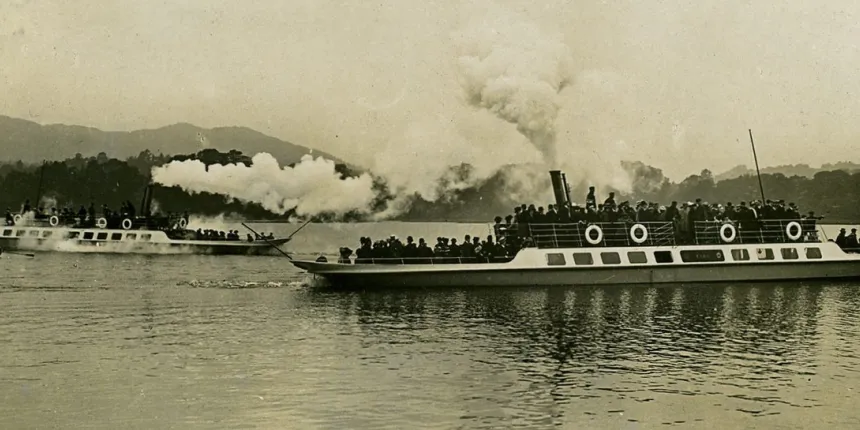
Building on strong foundations
Windermere, England’s biggest natural lake is 10.5 miles long, one mile wide at its widest point and in places, 200 feet deep. It not only boasts stunning beauty, but a rich and varied history. Sitting comfortably? Then we’ll begin…
The lake is subject to a public right of navigation and in centuries past supported commercial traffic associated with slate and copper mining, timber, wool and fishing. In the early years of the 19th century White and Gibson of Ambleside operated a sailing packet service. Their vessels carried passengers and general goods between Ambleside, Bowness, the Hawkshead Ferry and Newby Bridge.
This service connected with the Ulverston to Lancaster Stagecoach at the Swan Hotel at Newby Bridge, and with the Lancaster to Whitehaven Stagecoach at Ambleside. The full journey took 3.5 hours. Return fares were – Ambleside to Bowness 1/- (5p), Ambleside to the Ferry 1/6 (7.5p) and Ambleside to Newby Bridge 3/- (15p). Considering that an agricultural worker earned around 6/- (30p) a week at that time, fares were very high.
Other ferry operators, including John Braithwaite of Bowness, rowed passengers up and down the lake exchanging passengers and goods at the Hawkshead Ferry.
The idea of providing a Steamer service came from John Fell of Greenodd. Most of the capital for the Steamers came from Kendal and Ulverston. Only four shareholders lived close to Windermere – two came from Ambleside, one from Troutbeck and one from Bowness, the latter being Thomas Ullock, owner of the Royal Hotel.
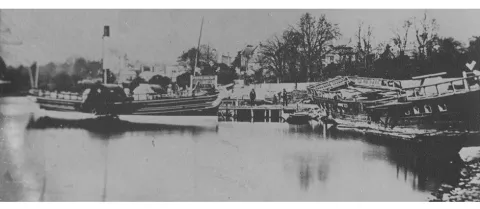
Lady of the Lake c1860
William Wordsworth fiercely opposed the launching of the first Steamer, ‘Lady of the Lake’ in 1845, but the ceremony at Newby Bridge - reported in the Illustrated London News, was attended by many famous people including Harriet Martineau and Lord Cavendish. Lady of the Lake was built by Richard Ashburner of Greenodd for the Windermere Steam Yacht Company and was the first Steamer to operate on an English Lake. She was 80ft in length with a beam of 11.5ft, a depth of 6.4ft and a steam engine rated at 20 hp.
The ship was built of wood with a short bowsprit. The tall slim funnel, placed aft of the paddle boxes, was painted black with a broad white stripe. The band of the Kendal Cavalry entertained passengers on the maiden voyage to Ambleside and dancing took place on the top deck.
Richard Ashburner originally designed the vessel as a screw Steamer but the water at Newby Bridge was too shallow so she was built as a paddle Steamer to facilitate travel along the river Leven to the terminus at the Swan Hotel.
Lady of the Lake carried 200 passengers and boasted a luxurious first class saloon fitted with mirrors and carpets. Her hull was finished in black and gold with a white figurehead. She continued in service until 1865.
The Yacht Company launched a similar Steamer, Lord of the Isles in 1846. Unfortunately her career was short-lived; she was destroyed by fire in 1850 while moored at Bowness pier. The fire occurred in suspicious circumstances and the fireboys were accused of wilfully setting fire to her. The lads were locked up in Appleby Prison to await trial at the local Assize Court but the case was dismissed. The judge ruled that it was unlikely that the boys would have deliberately destroyed the vessel as by doing so they would have denied themselves work.
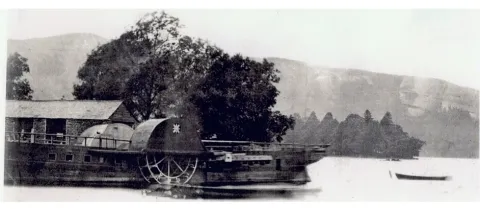
Lord of the Isles (after a fire).
In 1847 a second company, the Windermere Iron Steamboat Company, was formed to run cruises in conjunction with the newly opened Kendal to Windermere Railway. In 1849 they launched the Firefly, a 75ft long Steamer constructed by McConochie & Claude of Liverpool. She was launched with steam up at 9pm on the evening of August 1st 1849 at Low Wood near Ambleside. The boat was economical to run, required only half the crew, burnt a quarter of the coal, and was faster than her rivals.
The Windermere Iron Steamboat Company commissioned a second vessel, the Dragonfly, which was launched in November 1850. She was the largest Steamer on the lake, 95ft in length and 16.5ft in breadth.
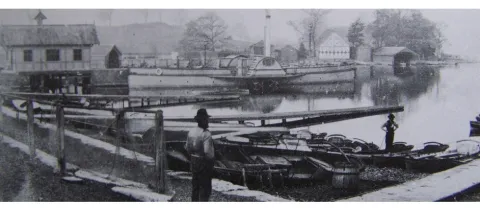
Dragonfly at Bowness Pier
With the arrival of the faster ships, competition between the companies began in earnest. Fares were slashed, touts were employed at the piers (later to be banned by the Bowness Local Government Board) and handbills and posters were distributed in their thousands.
The Lady of the Lake was slower than her rivals and often, when the Dragonfly passed her on the lake, the latter’s band struck up "The Girl I Left Behind", a popular song of the day, much to the amusement of those on board who hurled amiable insults at each other as they drew level.
After years of wasteful competition the two companies joined forces as the Windermere United Yacht Company in 1858.

Lakeside: the southernmost pier on Lake Windermere & station on the Furness Railway line.
In 1865 the Furness Railway Company resolved to build a branch line from Ulverston to Newby Bridge and on July 16th 1866 an Act of Parliament was obtained to authorise the works. The line was speedily built and extended to a Steamer/train interchange at Lakeside. The first official train to work over the whole line, hauled by locomotive number 21, ran from Barrow to a temporary station at Lakeside on June 1st 1869.
Another local railway line also made an impact on the steamer service. The Kendal to Windermere Railway opened in 1847. The branch attracted many holidaymakers and in its first full year carried 120,000 passengers.
A sizeable settlement grew up around the railway station with lodging houses, shops, hotels and pubs producing rich dividends for their owners. The combined population of Windermere and Bowness increased from 2085 in 1851 to 4613 in 1891.
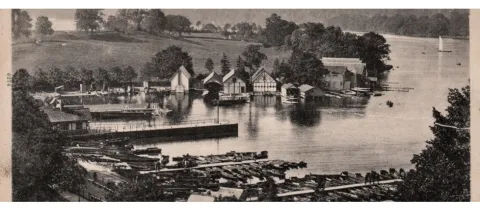
Bustling Bowness during the 'boom-time' of the late 1800s
In 1866 the Furness Railway entered into an agreement with the Windermere United Yacht Company to purchase Steamer shares and in 1872 the Railway Company took sole control.
The Steamers continued in Furness Railway ownership until the national grouping of railways in 1923 when they became part of the LMS (London Midland Scottish Railway) Company.
Other Steamers introduced into service during the second half of the nineteenth century included the Rothay, built by the Lancaster Shipbuilding Company in 1867. This was the last paddle steamer built for service on Windermere. The parts were brought to the port of Greenodd by the steamer Duchess of Lancaster and transported by horse and cart to Newby Bridge for assembly. The ship had a rudder at each end to help it manoeuvre in the shallow waters of the river Leven at Newby Bridge; it was scrapped in 1891.
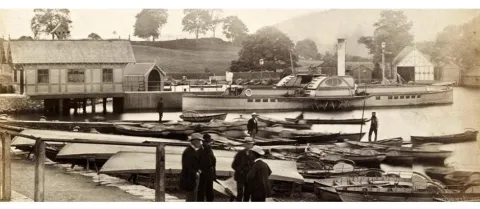
Rothay in Bowness
Seath & Company of Glasgow were awarded a contract to build Swan, a 147 ft coal fired iron hulled steamer with a capacity of 488 passengers. Launched in 1869 she had a chequered career. In 1893 she sank at her moorings at Lakeside in a gale and, a few years later, sank again after a collision with Tern off Storrs Hall. Her most famous misfortune occurred on September 27th 1909 when she ran aground at Belle Grange in fog. She was refloated two days later when Tern and Swift, in tandem, towed her back into the water.
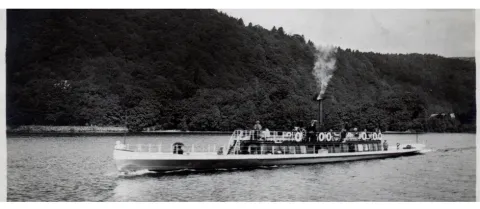
Windermere Steam Yacht Swan (1)
In 1871 the Furness Railway Company purchased a cargo Steamer, the Raven, from Seath & Company. The boat carried mail, coal, timber, farm produce and general cargo to the houses, hotels and businesses around the lake and to railway warehouses at Bowness and Ambleside. During the winter she acted as an ice breaker for the Steamers which operated an all year-round timetable until 1921.
In 1922 Raven was withdrawn from service and sold to Vickers Armstrong of Barrow-in-Furness for testing mine-laying equipment. Eventually, after being abandoned at Lakeside for many years, she was saved for preservation, restored, and is currently exhibited at the Windermere Steamboat Museum. She is the second oldest ship on Lloyd’s Register and the oldest with her original machinery.
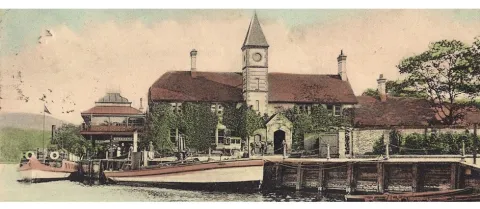
Lakeside Station with Raven at the pier.
In July 1878 the Board resolved to build two more Steamers at a cost of £3,400 each, "there being £12,000 in the Steamer depreciation account". The contract was awarded to the Barrow Shipbuilding company who constructed near identical vessels, Cygnet and Teal, which were launched at Lakeside in 1879. Teal was scrapped in 1929; Cygnet was converted to a motor vessel (paraffin engines) in 1923 before being withdrawn from service in 1936. However she was used for occasional charter and relief work until the Second World War and, in 1947, was used during the summer season when government austerity restrictions called a temporary halt to the running of the coal fired Steamers.

Steam Yacht Cygnet
Traffic on the lake continued to grow rapidly during the Victorian years and in 1890 the Furness Railway commissioned Forrest & Sons of Wyvenhoe, Essex, to design and build a new Steamer. Originally to be called Swallow, a last minute change of heart resulted in the vessel being named Tern. Launched in June 1891 with a passenger capacity of 633, Tern still sails today as the flagship of the Windermere fleet.
Ten years later, Swift, the last of the coal fired Steamers was commissioned. The largest vessel ever built for service on Windermere, she was launched in 1900 at a cost of £9,500. Powered by steam compound engines developing 63.75 nautical horse power, she carried 781 passengers. Swift sailed as a steam vessel until 1956 when her boiler burst and British Rail installed Glennifer diesel engines in time for the 1957 season. She continued in service until 1981 when she was laid up at Lakeside. Sadly, after attempts to preserve her failed, she was broken up in 1999.
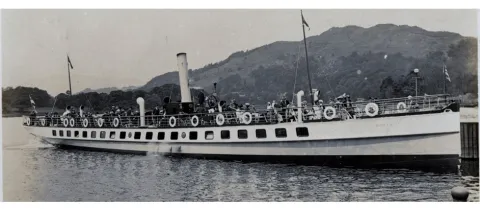
Steam Yacht Swift at Ambleside Pier
The last vessel purchased by the Furness Railway was Britannia, in 1907. Built by Seaths in 1879 as a private yacht for Col. G. Ridehalgh of Fell Foot, she carried 122 passengers in extreme comfort. Used as a charter vessel prior to the First World War she was laid up in 1915 and scrapped in 1919.
The Furness Railway ceased to exist in 1923 when its operations were transferred to the newly established LMS (London Midland Scottish Railway).
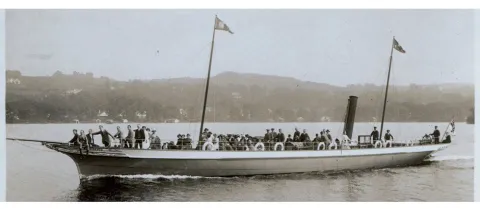
Steam Yacht Britannia
In 1935 the LMS resolved to update and improve the Windermere fleet. A new motor vessel, Teal, was ordered from Vickers Armstrong, of Barrow-in-Furness, and launched at Lakeside on July 4th 1936. A small ship by Vickers standards, Teal displaced 250 tons and had room onboard for 877 passengers. She operated as a two-class ship with first and third class accommodation on three decks.
Her moment of glory came in August 1956, when she carried Her Majesty Queen Elizabeth II and the Duke of Edinburgh from Ambleside to Bowness. In 1990 the Queen kindly consented to re-sign the photograph displayed on the ship to commemorate her visit.
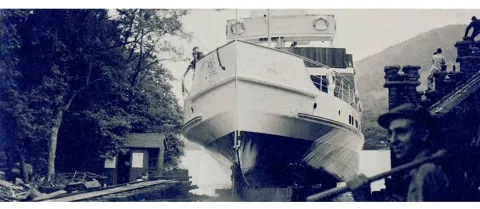
Launch of Teal on Lakeside Slipway
Teal proved so popular that, the following year, the LMS commissioned a sister ship, the Swan, also constructed by Vickers Armstrong. This vessel made her maiden voyage on June 24th 1938 when she carried delegates to the 37th Annual Conference of the Municipal Tramways and Transport Association on a charter from Lakeside.
Both vessels operate today under the Windermere Lake Cruises flag; they have been much improved and new engines were fitted in recent years.
Passenger numbers increased dramatically in the years immediately after the Second World War. LMS operations, including the Windermere Steamer fleet, passed into the custodianship of the British Transport Commission on January 1st 1948 when the railway companies were nationalised.
In the 1950s British Rail ran regular excursions including one from Birmingham on Summer Sundays for £1 per adult return. Passengers joined the train in the morning for a trip to Windermere Town Station where they were allowed time for shopping before boarding a Steamer at Bowness for a lake cruise via Ambleside before boarding their return train at Lakeside, arriving back in Birmingham at 1 o’clock in the morning.
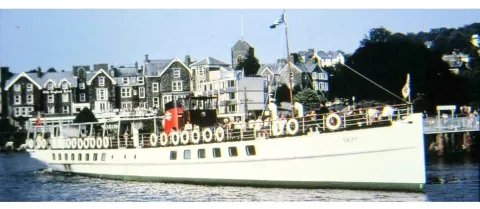
Swift in British Rail livery
On January 1st 1963 the British Railways Board, under the Chairmanship of Dr. Richard Beeching, took over responsibility from the BTC for the "management of British Railways and some other activities". These activities included "managing the shipping services vested in the British Railways Board". For many years control of the Steamers was in the hands of Captain A. E. Willmott DSC, the District Marine Manager and Harbour Master at the Port of Heysham (Lancs). His Windermere based assistant was Marine Engineer Foreman Richard Jones. After serving as an engineer on Elders and Fyffes banana boats Mr. Jones joined the LMS and was posted to Windermere in 1935. Other than wartime service was a RNR Officer (when he was decorated) he remained with the Steamers until his retirement in 1967.
Sadly, the branch railway line from Ulverston to Lakeside closed on September 5th 1965, leaving the Steamers without a direct main line rail link. Fortunately, a band of enthusiasts raised money to re-open the section of line, from Haverthwaite to Lakeside and the first train ran on May 5th 1973.
In 1970 British Rail’s marine division was renamed Sealink and the Steamer operation rebranded "Sealink Windermere". In 1984 Sealink was privatised and passed into the ownership of the International shipping conglomerate Sea Containers who renamed it "The Windermere Iron Steamboat Company", thus resurrecting a name from the distant past. Control of WISCO passed to the Sea Containers subsidiary, Orient Express Hotels.
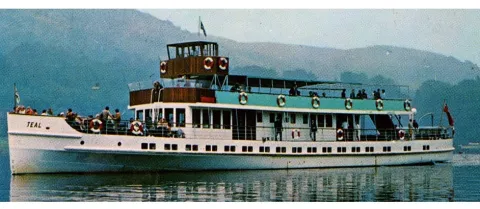
Teal in Sealink livery
In May 1993 the company returned to private local ownership when the Bowness Bay Boating Company purchased it. Today historic Steamers sail alongside elegant launches such as Miss Lakeland, Miss Cumbria and Queen of the Lake. Collectively, the company operates under the Windermere Lake Cruises house flag. Since the merger a considerable amount of money has been expended on improving every aspect of the business and this has been acknowledged in awards that the company has won in recent years.
Vessels, piers and buildings have been refurbished and updated and the company, through its commitment to sustainable tourism, plays an important part in supporting the local economy.
The day-tripper was, and is, the lifeblood of the service on Windermere.
Today the vast majority of passengers arrive by car or coach but the British Rail connection at Windermere remains and a portion of the old Lakeside branch prospers as a preserved steam railway.
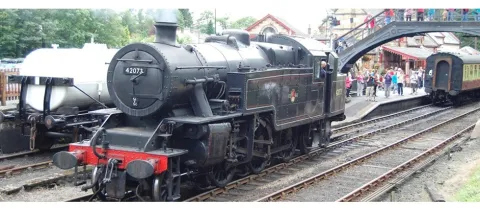
Lakeside & Haverthwaite Railway today (originally the Ulverston to Lakeside branch line)
Services operate all year round and visitors can still experience a journey first enjoyed by their ancestors long before the coming of the motor car.
Speaking of which… You can learn about the history of cars with our friends at the Lakeland Motor Museum, here: www.lakelandmotormuseum.co.uk
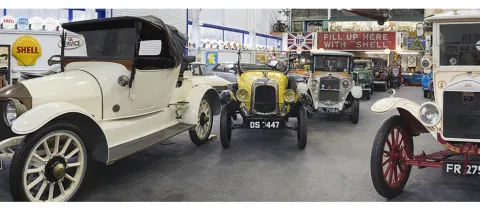
Vehicles on display at Lakeland Motor Museum at Backbarrow near Newby Bridge
It was announced in May 2019 that a new 300-seater boat would be added to the Windermere Lake Cruises fleet. MV Swift (II) is expected to be launched in Autumn 2020. Find out more here.

MV Swift being gently lowered into Windermere for first time in December 2019
To find out more about the history of pleasure craft on Lake Windermere try these useful sources: